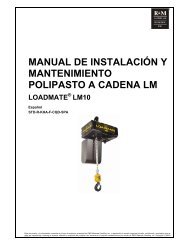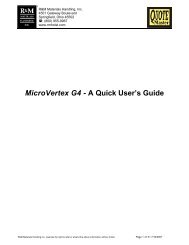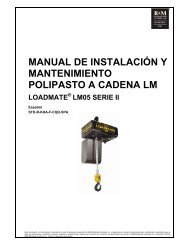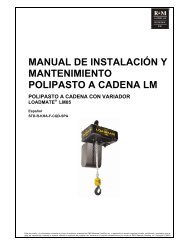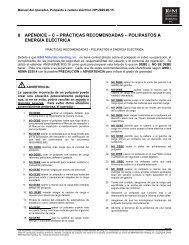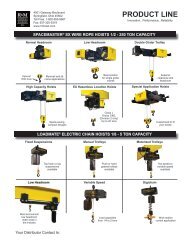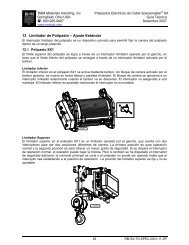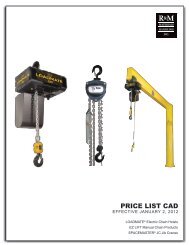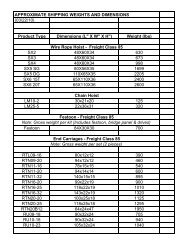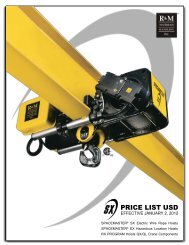Spacemaster® EX Electric Wire Rope Hoist Technical Guide
Spacemaster® EX Electric Wire Rope Hoist Technical Guide
Spacemaster® EX Electric Wire Rope Hoist Technical Guide
Create successful ePaper yourself
Turn your PDF publications into a flip-book with our unique Google optimized e-Paper software.
®<br />
R&M Materials Handling, Inc Spacemaster ® <strong>EX</strong> <strong>Electric</strong> <strong>Wire</strong> <strong>Rope</strong> <strong>Hoist</strong><br />
Springfield, Ohio USA <strong>Technical</strong> <strong>Guide</strong><br />
: 800 955-9967 June 2010<br />
www.rmhoist.com<br />
2 <strong>Hoist</strong> <strong>Technical</strong> Characteristics - Class I, Division 2<br />
The technical characteristics for Class I, Group C&D, Division 2 hoists are a summarized in the following<br />
tables. The information in the first table is in U.S. units and the information in the second table is in metric<br />
units. The information in the tables include:<br />
Reeving type<br />
Availability of standard suspension types for each model<br />
<strong>Hoist</strong> duty rating<br />
Height of lift and corresponding drum length code<br />
<strong>Hoist</strong> speeds including alternate speeds<br />
<strong>Rope</strong> type code for each model<br />
2.1 Height of Lift and Drum Code<br />
The height of lift along with the corresponding drum length code is listed for each basic model. The drum<br />
code is included in the hoist model code.<br />
2.2 Reeving<br />
See <strong>Hoist</strong> Model Code Description for explanation of the reeving code.<br />
2.3 <strong>Hoist</strong> Speeds<br />
The hoist speeds for Class I, Group C&D, Division 2 hoists, along with the corresponding gear code and<br />
motor type, are listed in the technical characteristics tables. The gear code and motor type are included in<br />
the hoist model code. (Note: VFD controls are not available for these <strong>EX</strong> hoists.)<br />
2.4 Suspension Type Code<br />
Some of the suspension codes used in the <strong>Hoist</strong> Characteristics table may vary from those used in the<br />
price book. Suspension types that are available for each hoist model are marked with a code. Special<br />
suspensions are not included here.<br />
Suspension Code (in Table) Description<br />
L Low headroom trolley<br />
DH Double girder trolley–high: Height of trolley above the rail is higher than<br />
the standard trolley - to get better headroom below the rail.<br />
DM Double girder trolley–standard (medium connection)<br />
DW Double girder trolley–low: Height of trolley above the rail is lower than<br />
the standard trolley – to get better overhead clearance but it increases<br />
headroom.<br />
N Normal headroom trolley<br />
F Foot mount<br />
2.5 <strong>Rope</strong> Type Code<br />
The rope type code is listed for each height of lift. The characteristics of the wire rope can be found in the<br />
<strong>Wire</strong> <strong>Rope</strong> section. The double-reeved hoists use two separate ropes – a right-hand lay and a left-hand<br />
lay.<br />
2.6 <strong>Hoist</strong> Duty Rating<br />
ASME hoist duty rating (H3, H4, etc.) applies to hoists marked with conventional U.S. capacities (for<br />
example 1 ton = 2000 lbs = 907 kg) and does not apply to hoists marked with conventional metric<br />
capacities (for example 1 metric ton = 1,000 kg = 2,200 lbs).<br />
5<br />
RM-<strong>EX</strong>-TG-2010-0-ENG.doc



